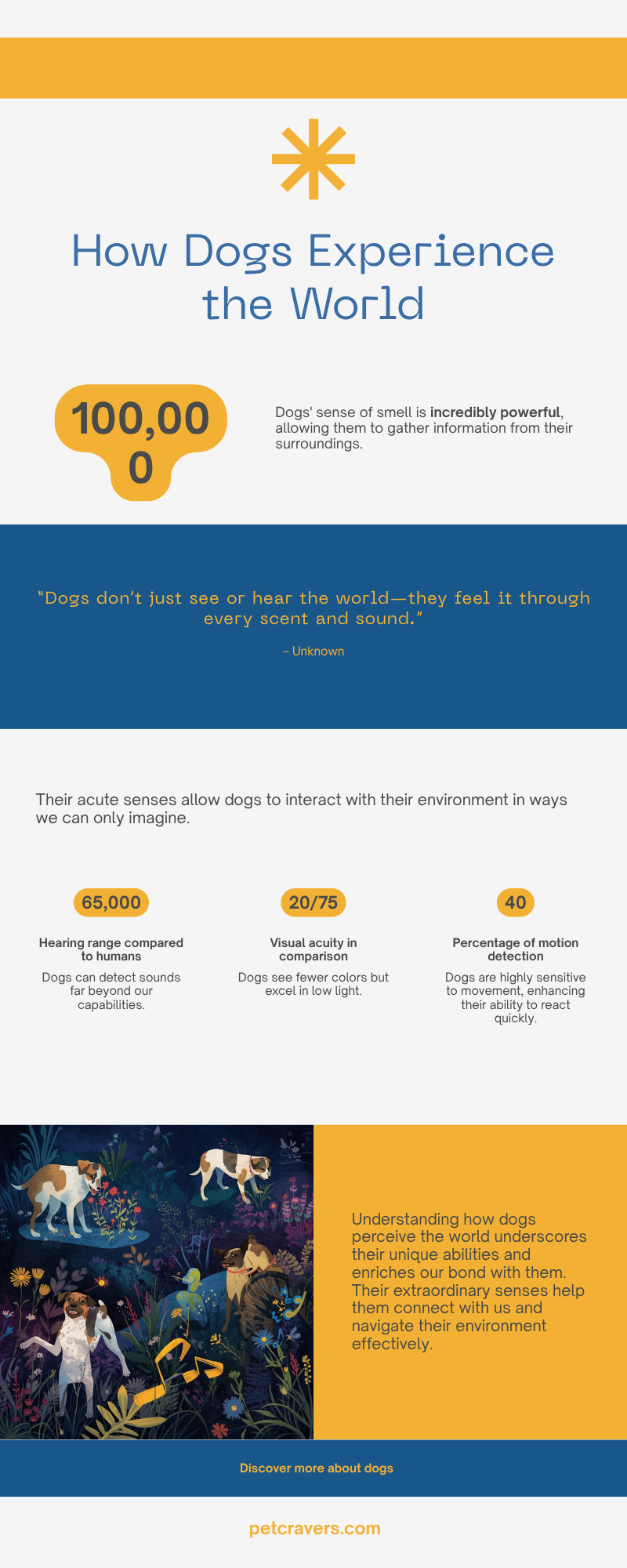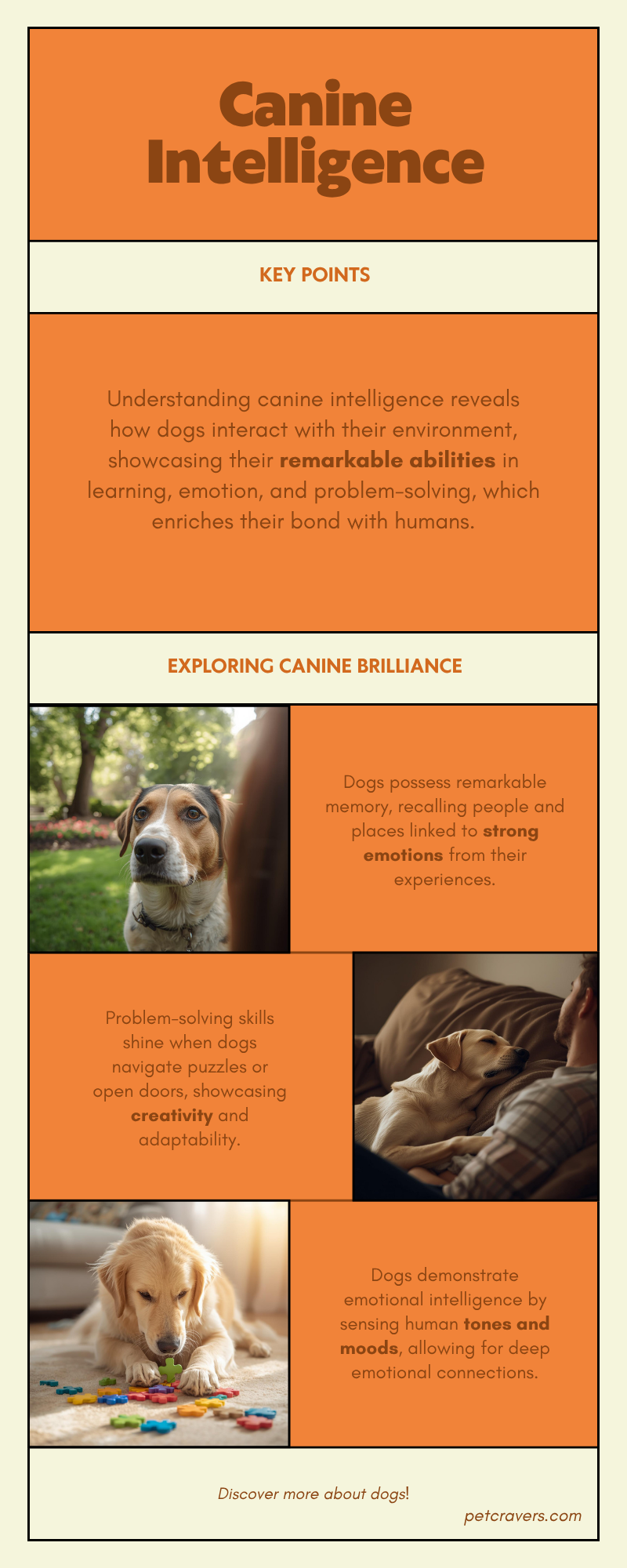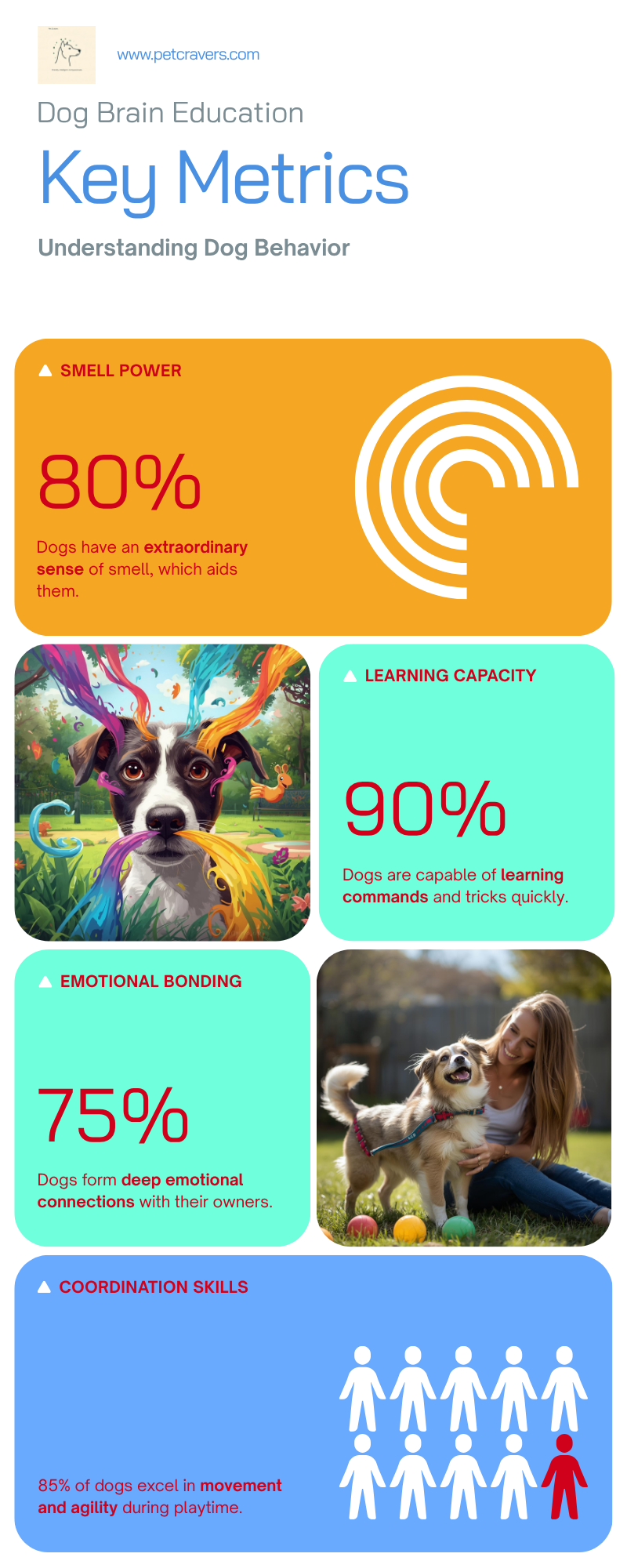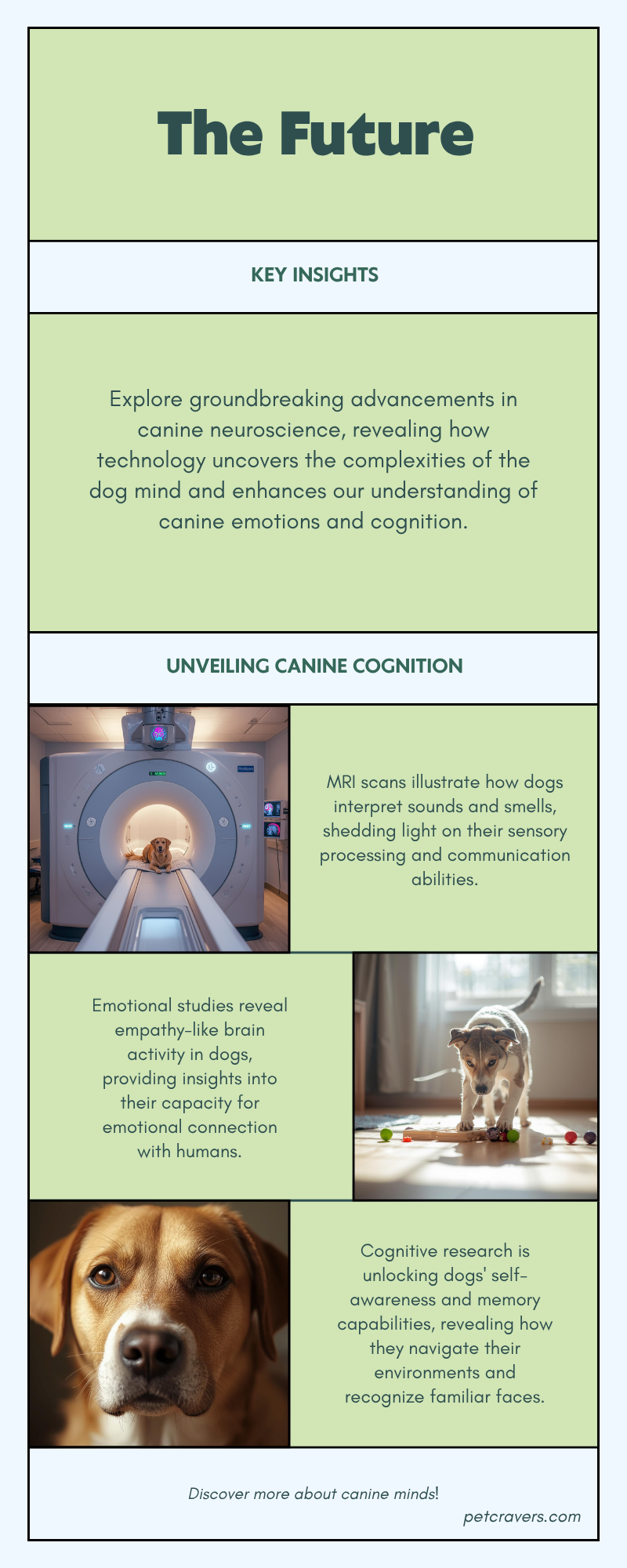Introduction
Have you ever caught yourself staring at your dog and wondering, “What’s going on in that furry head?” From tilting their ears at strange sounds to recognizing the sound of your footsteps, dogs constantly amaze us with their intelligence and emotional depth. But behind every wag, bark, and curious glance lies a fascinating science—the inner workings of a dog’s brain.
Understanding how a dog’s brain functions doesn’t just satisfy curiosity; it helps us strengthen our bond with them, improve training, and even support their mental health as they age. In this post, we’ll explore the anatomy, senses, intelligence, and emotional world of dogs through the lens of neuroscience—revealing why our four-legged companions are far more complex than we often imagine.
Anatomy of a Dog’s Brain
At first glance, a dog’s brain looks similar to ours—it has the same basic structures, but it’s smaller in proportion to body size and wired a little differently. While the human brain is designed for complex reasoning and language, the dog’s brain has evolved to excel in survival skills, sensory perception, and social bonding.

Here are the major regions that make a dog’s brain so unique:
Olfactory Bulb (The Powerhouse of Smell):
This is the superstar of the canine brain. It’s about 40 times larger (relative to brain size) than in humans, giving dogs the incredible ability to sniff out scents we can’t even imagine. That’s why they can detect diseases, find missing people, and even sense emotions.
Cerebral Cortex (Thinking & Learning):
Just like in humans, this part handles problem-solving, learning, and memory. Though smaller than ours, it still allows dogs to recognize words, follow commands, and learn through repetition.
Limbic System (Emotions & Bonding):
This is the emotional center of the dog’s brain. It’s responsible for feelings of fear, joy, love, and even anxiety. It also plays a key role in the strong bond dogs form with humans.
Cerebellum (Movement & Coordination):
This region keeps dogs agile and balanced, allowing them to run, jump, and chase with precision.
In short, while dogs may not rival humans in abstract thought or language, their brains are highly specialized for the things that matter most in their world: sensing, moving, learning, and loving.
How Dogs Perceive the World
If humans are visual creatures, dogs are olfactory creatures. Their brains are wired to process the world very differently from ours, and it all starts with their senses. To truly understand how dogs think and behave, we need to step into their unique sensory universe.

Smell: Their Superpower
A dog’s sense of smell is legendary—and for good reason. The part of the brain devoted to smell is proportionally 40 times larger than in humans. Dogs can detect scents at concentrations nearly 100,000 times lower than what we can perceive. That’s why they can track missing people, sniff out drugs, or even detect illnesses like cancer and diabetes. For a dog, every sniff is like reading a detailed story about the environment.
Hearing: Detecting What We Can’t
Dogs can hear frequencies up to 65,000 Hz, far beyond the human range of about 20,000 Hz. That’s why your pup perks up at sounds you don’t notice—like a dog whistle or the faint rustle of a mouse behind the wall. Their ability to hear higher frequencies and pinpoint direction quickly makes them excellent at detecting movement or intruders.
Vision: A Different Spectrum
Contrary to the old myth, dogs aren’t color-blind—they just see the world differently. Instead of the full rainbow humans see, dogs perceive mainly shades of blue and yellow. Reds and greens appear as muted browns or grays. While their color vision is limited, their eyes are adapted for detecting motion, especially in low light. That’s why your dog might notice a squirrel darting across the yard long before you do.
Together, these senses create a rich, layered perception of the world—one that’s less about colors and more about scents, sounds, and subtle movements.
Canine Intelligence and Learning
Dogs may not solve algebra equations or write poetry, but their brains are remarkable in their own right. Their intelligence lies in adaptability, problem-solving, and—most importantly—their ability to understand humans.

Memory: More Than Just Short-Term
Dogs have both short-term and long-term memory. While their short-term recall isn’t as sharp as ours (they may forget a command after a few minutes if not reinforced), their long-term memory is impressive. They remember people, places, and routines for years—especially when those memories are tied to strong emotions like love or fear.
Problem-Solving Skills
Many dogs can figure out puzzles, open doors, or even learn how to get their favorite toy out of a tricky spot. Breeds like Border Collies, Poodles, and German Shepherds are especially known for their sharp problem-solving abilities. This intelligence is why dogs excel in roles like search-and-rescue, service work, and competitive sports.
Emotional Intelligence
One of the most fascinating aspects of canine cognition is their emotional awareness. Studies show dogs can read human facial expressions, detect tone of voice, and respond to our moods. They know when you’re happy, stressed, or sad—and often adjust their behavior accordingly. Some researchers suggest this ability is part of why dogs became such close companions to humans throughout history.
Learning Through Conditioning
Dogs primarily learn through association and repetition. Whether it’s classical conditioning (bell rings, food comes) or positive reinforcement (sit, get a treat), their brains are wired to connect actions with outcomes. This is the science behind effective dog training.
In short, dogs may not have human-like intelligence, but their unique blend of memory, problem-solving, and emotional awareness makes them incredibly smart in ways that matter most for survival—and for living alongside us.
Social Behavior and Communication
Dogs are social animals by nature, and their brains are finely tuned to pick up on cues from both other dogs and humans. This ability to “read the room” is part of what makes them such incredible companions.

Reading Human Cues
Your dog doesn’t understand every word you say, but their brain is excellent at processing tone, body language, and even subtle gestures. Studies using brain scans show that dogs’ auditory cortex lights up differently when they hear praising tones compared to neutral ones. In other words, they know when you’re happy with them—even if they don’t fully understand the words.
Mirror Neurons and Empathy-Like Responses
Dogs often mirror our emotions. If you’re excited, they wag and jump; if you’re sad, they may curl up quietly beside you. This is believed to be linked to mirror neurons in their brain, which help them sense and reflect the emotional states of others. While it may not be empathy in the human sense, it’s the closest animal equivalent—and it deepens the bond we share.
Pack Mentality and Social Bonding
Canine brains are hardwired for cooperation. Descended from wolves, dogs retain a strong sense of hierarchy and pack dynamics. Living with humans, they adapt this instinct—viewing their family as their “pack.” This is why consistent rules, leadership, and companionship are so important for a dog’s mental well-being.
Communication Between Dogs
Barks, growls, howls, tail wags, and even ear positions are processed in the canine brain as a rich language of signals. Dogs don’t just communicate with us; they’re constantly exchanging information with one another through these cues.
In essence, dogs are not only tuned into our words and actions but also deeply shaped by their own social instincts. Their brains thrive on interaction, making companionship an essential part of their mental health.
The Bond Between Dogs and Humans
Few relationships in the animal kingdom rival the bond between dogs and humans. What feels like unconditional love has a fascinating biological foundation in the canine brain.

Oxytocin: The “Love Hormone”
When you look into your dog’s eyes or pet them, both your brain and your dog’s brain release oxytocin—the same hormone that strengthens bonds between mothers and babies. This chemical surge fosters trust, attachment, and feelings of comfort. It’s no wonder dogs are often called “man’s best friend.”
Recognizing Their Humans
Brain imaging studies show that when dogs hear their owner’s voice or smell their scent, the reward centers of their brains light up. This means your presence alone can bring them joy at a neurological level. To your dog, you’re not just a companion—you’re the center of their emotional world.
Loyalty Written in the Brain
Dogs’ limbic systems, which process emotions, play a key role in their remarkable loyalty. Unlike many animals, dogs don’t just stick around for food. Their brains are wired to seek social bonds, and once formed, those bonds are incredibly strong. This explains why dogs often show distress when separated from their owners and sheer excitement upon reunion.
Why This Bond Matters
This deep connection has practical benefits, too. Therapy dogs and emotional support animals leverage this brain chemistry to reduce human stress, anxiety, and even physical pain. The bond is truly mutual—helping both species thrive.
In short, the love you feel from your dog isn’t just in your imagination. It’s supported by powerful neurochemistry that makes your bond one of the most unique and rewarding in nature.
Dog Brain Development Across Life Stages
Just like humans, a dog’s brain goes through distinct stages of growth and change. Understanding these stages can help you train, care for, and support your dog at every age.

Puppy Brain: Curiosity and Socialization
Puppies are born with a brain wired for learning and exploration. During the first few months, their neurons form millions of new connections, making this period critical for socialization, training, and emotional development. Positive experiences during this stage—like meeting new people, other dogs, and different environments—shape their confidence and behavior for life.
Adult Brain: Peak Cognitive Function
By the time dogs reach adulthood, their brains are fully developed. They have strong memory, problem-solving skills, and emotional intelligence. This is the stage where dogs excel in training, work, and complex tasks. Maintaining mental stimulation—through games, obedience training, or puzzle toys—helps keep their adult brains sharp and engaged.
Senior Dog Brain: Aging and Cognitive Changes
As dogs age, their brains show signs of natural decline, similar to humans. Memory may fade, learning new commands can become harder, and some dogs develop canine cognitive dysfunction—the dog equivalent of dementia. Early recognition, mental exercises, and proper nutrition can slow these changes and improve quality of life for senior dogs.
By understanding the stages of a dog’s brain development, owners can provide age-appropriate care, training, and enrichment—helping their dogs thrive from playful puppies to wise seniors.
Keeping Your Dog’s Brain Healthy
A healthy brain is key to a happy, well-behaved dog. Just like humans, dogs need mental stimulation, physical activity, and social interaction to keep their minds sharp throughout life.

Mental Stimulation
Dogs need challenges to prevent boredom and maintain cognitive function. Puzzle toys, scent games, hide-and-seek, and training sessions engage their problem-solving skills and memory. Even a simple game of “find the treat” can activate multiple areas of the brain.
Physical Activity
Exercise isn’t just about burning energy—it also boosts brain health. Physical activity increases blood flow to the brain, supports neuron health, and releases endorphins that reduce stress. Daily walks, play sessions, and interactive activities keep both body and mind in top condition.
Social Interaction
Dogs are social creatures, and interaction with humans and other dogs is essential. Regular play, training, and bonding time stimulate emotional centers in the brain, reducing anxiety and promoting happiness. Socialization also prevents behavioral issues and helps senior dogs maintain mental sharpness.
Nutrition and Brain Health
A balanced diet rich in omega-3 fatty acids, antioxidants, and essential nutrients supports brain function. Special senior dog formulas may help slow cognitive decline in older pets.
By combining mental exercises, physical activity, social engagement, and proper nutrition, you can help your dog’s brain stay active, healthy, and happy throughout their life.
The Future of Dog Brain Research
The science of canine cognition is still evolving, and recent studies are revealing just how complex a dog’s mind truly is. Advances in technology are allowing researchers to peek inside the brain without invasive procedures, opening new doors for understanding and care.

MRI Studies and Brain Imaging
Functional MRI (fMRI) scans now let scientists observe how dogs’ brains respond to sounds, smells, and human interaction in real time. For example, studies show that dogs’ reward centers light up when they hear a familiar human voice, providing direct evidence of their emotional attachment and cognitive processing.
Insights into Canine Consciousness
Research is beginning to explore whether dogs possess a form of self-awareness or consciousness. Experiments with problem-solving, memory, and emotional recognition suggest that dogs experience a rich inner life, one that includes emotions, learning, and social understanding.
Medical Advances for Brain Health
Understanding the canine brain better could lead to treatments for cognitive decline, anxiety, and neurological disorders. Scientists are studying supplements, medications, and training methods to slow age-related brain changes and improve the quality of life for senior dogs.
What This Means for Dog Owners
As science progresses, owners will gain practical tools to nurture their dog’s mental and emotional health. From improved training methods to preventive care for cognitive issues, the future of dog brain research promises a deeper bond and healthier lives for our canine companions.
Conclusion
Dogs are far more than loyal companions—they are intelligent, emotional, and socially complex beings with brains uniquely adapted to perceive, learn, and bond. From the incredible power of their sense of smell to their ability to read our emotions, dogs experience the world in ways we are only beginning to understand.
Science shows that their intelligence, social skills, and emotional depth are deeply rooted in brain structures and neurochemistry, making every wag, bark, and nuzzle meaningful. By understanding how their brains work, we can provide better care, enrich their lives, and strengthen the bond that has connected humans and dogs for thousands of years.
In the end, appreciating the science behind a dog’s brain doesn’t just satisfy curiosity—it deepens our love and respect for these remarkable animals who share our lives, hearts, and homes.




Leave a Reply